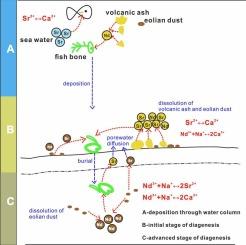Sources and enrichment processes of rare earth elements and yttrium in fish bones from deep-sea sediments: A study from the Wake Seamounts area in the western North Pacific Ocean
IF 3.6
2区 地球科学
Q1 GEOLOGY
引用次数: 0
Abstract
Fish bones (bio-phosphate) are the primary carrier of rare earth elements (REE) and yttrium (Y), collectively termed REY, in deep-sea sediments. However, the specific processes that contribute to the enrichment of REY in bio-phosphate remain unclear. In this study, we perform integrated analyses of sediments and individual minerals of bio-phosphate along the core profile of a sediment column, numbered GC12, which was retrieved from the western North Pacific Ocean. We find that strontium (Sr) and neodymium (Nd) isotopes of bio-phosphate offer a comprehensive and detailed understanding of REY sources and enrichment processes. Living fish absorbs Sr from seawater into their bones. After death, when bones settle down through the water column, they begin to absorb REY from seawater, which are released by dissolved volcanic ash. When bones settle down on the seafloor, at the initial stage of diagenesis (depths < 100 cmbsf), they preferentially absorb Sr relative to REY due to the locally high Sr concentrations created by the rapid dissolution of volcanic ash. At the advanced stage of diagenesis (depths > 100 cmbsf), where volcanic ash is exhausted, the enrichment of REY in bones occurs through replacing Sr derived from volcanic ash with REY from the dissolution of terrigenous debris. Furthermore, we find the sorting effect caused by abrupt changes in sedimentary conditions may enhance the accumulation of bio-phosphate in sediments, promoting the enrichment of REY in sediments. The findings of this study may broaden the application of bio-phosphate in marine geoscience.

深海沉积物鱼骨中稀土元素和钇的来源及富集过程——来自北太平洋西部威克海山地区的研究
鱼骨(生物磷酸盐)是深海沉积物中稀土元素(REE)和钇(Y)的主要载体,统称为REY。然而,导致REY在生物磷酸盐中富集的具体过程尚不清楚。在这项研究中,我们对北太平洋西部一个编号为GC12的沉积物柱的岩心剖面进行了沉积物和生物磷酸盐单个矿物的综合分析。我们发现生物磷酸盐的锶(Sr)和钕(Nd)同位素提供了对REY来源和富集过程的全面和详细的了解。活鱼从海水中吸收锶到它们的骨头中。人死后,当骨头在水柱中沉淀下来时,它们开始从海水中吸收REY,这是由溶解的火山灰释放的。当骨骼沉积在海底时,在成岩作用的初始阶段(深度<;100 cmbsf),相对于REY,它们优先吸收Sr,因为火山灰的快速溶解产生了局部高Sr浓度。成岩作用晚期(深度>;100 cmbsf),在火山灰被耗尽的地方,骨骼中REY的富集是通过用陆源碎屑溶解产生的REY取代来自火山灰的Sr而发生的。此外,沉积条件突变引起的分选效应可能会增强沉积物中生物磷酸盐的富集,促进沉积物中REY的富集。本研究结果可拓宽生物磷酸盐在海洋地球科学中的应用。
本文章由计算机程序翻译,如有差异,请以英文原文为准。
求助全文
约1分钟内获得全文
求助全文
来源期刊

Ore Geology Reviews
地学-地质学
CiteScore
6.50
自引率
27.30%
发文量
546
审稿时长
22.9 weeks
期刊介绍:
Ore Geology Reviews aims to familiarize all earth scientists with recent advances in a number of interconnected disciplines related to the study of, and search for, ore deposits. The reviews range from brief to longer contributions, but the journal preferentially publishes manuscripts that fill the niche between the commonly shorter journal articles and the comprehensive book coverages, and thus has a special appeal to many authors and readers.
 求助内容:
求助内容: 应助结果提醒方式:
应助结果提醒方式:


